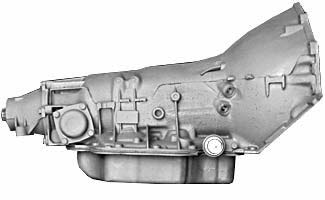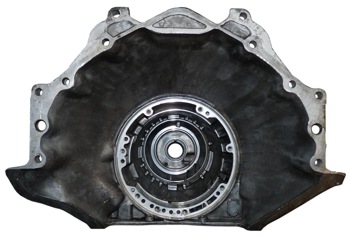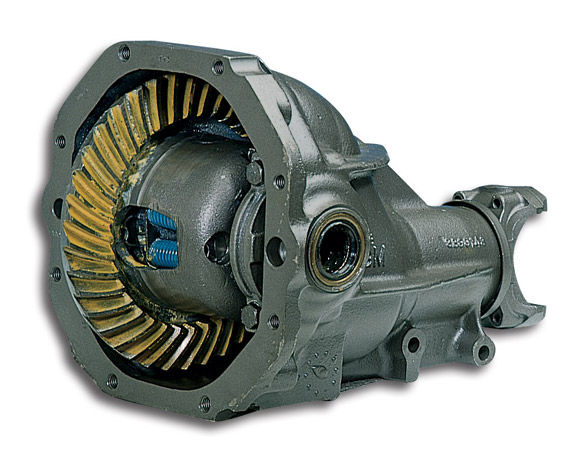The 1973 Corvette car came with a Tubro 400 Transmission, which I had rebuilt in Winnipeg at UltraTransmission
GM TH400 Automatic Transmission
The TH400 is an automatic shift, three-speed, longitudinally positioned transmission. It is widely regarded to be a supremely durable and legendary transmission.
The TH400 is conservatively rated at 450 ft. lbs. of input torque. Aftermarket building techniques take it well past that figure.
History
The Turbo 400 was introduced in 1964 in Buick and Cadillac cars and in Chevrolet and Oldsmobile cars the following year. An innovative variable pitch stator was available in the 1965-1967 cars that could essentially vary the characteristics of the torque converter. The design remained almost completely unchanged from its inception to 1991, but it was renamed 3L80 in 1987.
The THM400 can be visually identified by an oil pan number four shown at Transmission Pans. First introduced for the 1964 model year under the name “Turbo Hydra-Matic” in Cadillacs.[3] and “Super Turbine” in Buicks.[4] The following year, application expanded to Oldsmobile and Pontiac and to some full-sized Chevrolets. Many of the Buick, Cadillac, and Oldsmobile THM400s produced between 1964-67 were equipped with a Switch-Pitch torque converter variable-pitch stator, which is sought after by collectors and drag racers. These can be identified outside the vehicle (with the torque converter removed) by a narrow front pump spline. Externally the switch pitch version has two electrical connections, where the non-switch pitch THM400 has only one. GM used a Switch Pitch torque converter in the Buick twin turbine Dynaflow transmission between 1955–1963 and the Super Turbine 300 two speed transmissions used by Oldsmobile Pontiac, and Buick divisions between 1964-1967.
A variant of the THM400 known as a THM375 is a THM400 with a long output shaft that mates to the smaller THM350 drive shaft yoke. It can be identified by “375-THM” cast into the tailhousing. Internally the clutch packs originally had fewer friction plates. Some “Heavy Duty” THM350s were also designated THM375-B. Another variant is the 3L80HD, often referred to as a Turbo 475. The 3L80HD has a straight-cut planetary gear set. There is no externally visible way to determine whether the transmission contains the straight-cut planetary gear set. The THM425 front wheel drive transmission shares almost all its internal parts with the THM400.
By 1980, the relatively heavy THM400 was being phased out of usage in passenger cars in response to demand for improved fuel economy. The Presidential Limousine used during the ReaganAdministration, a modified 1984 Cadillac Fleetwood Brougham, was the last known GM passenger vehicle to use the THM400. The THM 400 was utilized in the C- and K-series (full size) Chevrolet/GMC pickups and G-series (full size) vans until 1990 when GM switched over to the 4L80E. Today, the United States Army HMMWV is the only vehicle using the THM400. The civilian Hummer H1 originally had the 3L80s, but the current model has had a 4L80E since the mid-1990s.
Through the end of the ’70s substantially more CBOP (Cadillac/Buick/Oldsmobile/Pontiac) bellhousing THM400s were produced than any other THM400. Chevrolet bellhousing THM400s, while not rare, can be hard to find and are, as a result, usually more expensive to buy. Other bellhousing patterns are, accordingly, rarer. The THM400 was never produced with a multicase bell housing.
Other auto manufacturers have used the THM400 and its 4L80E successor, including Ferrari (in the 400/412); Jaguar/Daimler (in pre-1994 XJ12 and XJ-S coupes) and their Daimler stable mates; Rolls-Royce (in 1965–1980 Silver Shadow and 1980-1992 Silver Spirit series cars, along with their Bentley stable mates); the Nissan Prince Royal; AM General; and Jeep (usually found in the FSJ pickups andSUVs). Early Jeep THM400s used an adapter between the engine and transmission bell housing while later models had an AMC specific housing. Though identical except for the bell housing pattern used through the ’60s and ending in 1979 the THM400 was mated to the Dana model 18,20 and was the only transmission used with the Borg-Warner 1305/1339 all-wheel-drive transfer case used only in Jeeps, It has been known to adapt a THM400 to other engines using adapters.
THM400 transmissions are very popular in automotive competition due to their great strength. Much of this strength comes from the use of a cast iron center support to suspend the transmission’s concentric shafts that join the clutch assemblies to the gear train. The center support, which is splined to the interior of the transmission’s case, also provides a robust reaction point for first gear (the gear train’s reaction carrier is restrained from counter-rotating the engine in first gear by a roller clutch whose inner race is part of the center support). Since the first gear reactive force is evenly distributed around the periphery of the case, the types of mechanical (and some times violent) failures that have plagued other competition transmissions are rare.
The THM400 was the first three-speed, Simpson-geared automatic to use overrunning clutches for both first and second gear reaction, a feature that eliminated the need to coordinate the simultaneous release of a band and application of a clutch to make the 2-3 gear change. Owing to this feature, as well as the use of a large, multi-plate clutch to provide second gear reaction, the THM400 is able to withstand very high input torque and an enormous number of shifting cycles, as would be encountered in frequent stop-and-go driving. As a result, it has met with considerable success in commercial vehicle applications.
For 1987, GM changed the nomenclature of their Turbo Hydramatic transmissions — the THM400 was renamed to the ‘3L80’ (three forward speeds, longitudinal positioning, and an arbitrary ‘strength’ of 80, the second highest such rating assigned). The 3L80HD was introduced in 1987 as the HD unit used in passenger trucks. In 1991, a four-speed overdrive version, the 4L80-E, replaced the THM400 in Chevrolet/GMC pickups, vans, SUVs, and commercial vehicles. The 4L80E (and its successor 4L85E) was the first Hydramatic to incorporate electronic controls — almost all of the THM400/3L80/3L80HD’s components are interchangeable.
Transmission fluid cooler line connections are found on the right hand side of the THM400. The lower connection is the cooler feed, and the upper connection is the return.[5] The case is tapped for either self-sealing 1/4″NPT fittings, or 1/2″UNF fittings with a washer seal. 5/16″ or 3/8″ rigid coolant lines are generally connected via appropriate double-flared adapters.
4-Wheel drive truck applications used a shorter output shaft that coupled with a female transfer case input shaft.Early transfer cases mated directly to the THM400 with an cast-iron adapter,usually a vertical oval shape.Later models used a circular style iron adapter which is generally considered the stronger of the two.
Weight: 135Lbs
Gear Ratios are:
- First Gear – 2.48:1
- Second Gear – 1.48:1
- Third Gear – 1.00:1
- Reverse – 2.07:1
The 1978 Corvette came with a Turbo 350 Transmission, which the previous owner had rebuilt.
GM TH350 Automatic Transmission
 The TH350 is an automatic shift, three-speed transmission. It is widely considered to be one of the greatest of automatic transmissions ever built.
The TH350 is an automatic shift, three-speed transmission. It is widely considered to be one of the greatest of automatic transmissions ever built.
The TH350 transmission was introduced in the 1969 model year as the successor to the GM Powerglide automatic transmission. Jointly developed by Chevy and Buick, it is also referred to as the CBC (Chevrolet-Buick Combined) 350. The Turbo 350 quickly become known for its strength, versatility and compactness.
The HydraMatic 350 transmission was prevalent in nearly all GM, rear-wheel-drive cars and trucks through 1984. It was typically paired with Small Block V6 & V8 engines. It was phased out of use and superceded by GM’s 700R4 starting in 1982.
The Turbo 350 is the shortest and one of the strongest automatics that can be put into a Jeep.
Identification
The 350 transmission is 21-3/4″ long and its one-piece case is cast of aluminum alloy. It features an integral bellhousing. The TH350 weighs 120 lbs. It has a distinctive oil pan that is chamfered at the passenger side, rear corner. At the right rear of the case is the modulator.
Weight: 120Lbs
Gear Ratios are:
- First Gear – 2.52:1
- Second Gear – 1.52:1
- Third Gear – 1.00:1
- Reverse – 2.07:1
The TH350-C was the lockup torque converter version introduced in the late 1979 model year, and was produced through 1984. This later version had an electronic lock-up converter to increase fuel-efficiency at cruising speeds. The TH350-C lockup version can be identified by an electrical plug on the left side of the transmission. When paired with an aftermarket TCC control unit, these can be desirable transmissions, and up to 10% more efficient at cruising speeds.
The conventional TH350 had part codes of M33, M38 & M39. The TH350C had codes of MV4, MX2, MX3 & MX5.
There were downsized derivatives of the TH350, designated TH200, TH200C, TH250, TH250C & TH375; a beefed up Buick version.
Features
The HydraMatic 350 may vary in clutch pack and band specifications. As a general rule, transmissions found behind larger engines will have stronger specs. If your Turbo 350 came from behind a lighter duty motor, don’t worry. These transmission can be affordably rebuilt with stronger components in nearly every area. Additionally, shift improver kits are available to provide firmer, quicker shifts, reducing slippage, heat and clutch wear. There are also many styles of torque converter to better configure the transmission for optimal use in the particular vehicle’s circumstances.
Transfer Case Adaptability
This transmission makes an excellent conversion transmission due to its adaptability into most Jeeps. Both 2wd and 4wd versions of the 350 can be used equally well, and there are no inherent advantages to either one once you have installed our adapter assembly.
 |
| A turn-key TH350, professionally built, OEM style or adapted and delivered to your door – ready for a variety of engines and Jeep transfer cases. Read more… |
2wd transmissions feature conical shaped tailhousings and an output yoke, which are replaced with a typically shorter 4wd style output shaft (most often included with our adapter assemblies) of varying lengths and spline counts, depending on the application. The HydraMatic can be adapted to the popular Jeep (and many IH) transfer cases, including the:
- Dana 18, 1941-1971
- Dana 20, 1962-1979
- Dana 300, 1980-1986
- New Process Jeep 208, 219 & 229
- New Process 207, 231, 241OR, 242 & 249
 |
Essentially all factory GM 4wd applications available with an OEM configured TH350 have adapters and transfer cases that are prohibitively long for a Jeep, and transfer cases whose sizes, strength and gearing fall short of desirable for most Jeep applications.
Engine Compatibility and Adaptability
GM
The front face TH350 is natively compatible with either the Chevrolet 90 degree “Small Block” & “Big Block” patterned engines, including the V6, V8, I6 & Iron Duke I4. Another version, the Buick / Oldsmobile / Pontiac (BOP) TH350 will be compatible with the Buick 90 degree V6 & V8 engines, and the Olds & Pontiac 90 degree V8. This “BOP” version features a “valley” at the twelve o’clock position of the block flange where the peak would be on the Chevy (pictured) version.
 These differences only affect the front bell of the case, and all TH350 cases are similar from that point back. Note that there are dual-pattern “uni-cases” compatible with both the Chevy and BOP style engine blocks.
These differences only affect the front bell of the case, and all TH350 cases are similar from that point back. Note that there are dual-pattern “uni-cases” compatible with both the Chevy and BOP style engine blocks.
 |
| The top dog of cool TH350 transmissions is the TH350C Unicase version, featuring both a Chevy / BOP pattern and a lockup torque converter. Note the letter “C” cast into its front face adjacent to the pump bore. |
AMC/Mopar Jeep
The TH350 can be made compatible with a variety of AMC I6 & V8 engines. See ourKit #437AMC for details. This kit can help make for a good Jeep powertrain.
TH350 Parts
Novak does carry a full line of parts for the TH350 transmission, including OEM grade and upgrade components for individuals working on their transmissions. If interested, we welcome you to contact us.
Additional Sources
Ron Sessions’ book, Turbo Hydra-Matic 350 Handbook, ISBN 0-89586-051-1, is a great read and will bring the reader a level of detail on the history, rebuilding and improvements one can make to these great gearboxes.

